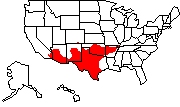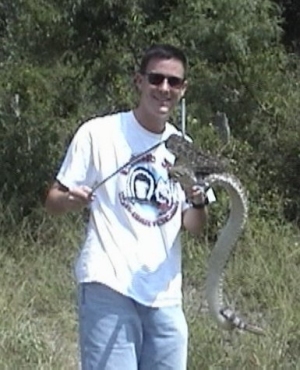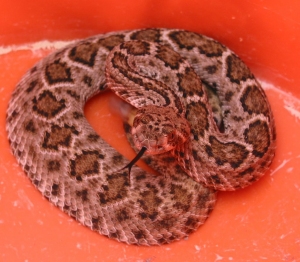|
Western Diamondback Rattlesnake
|
- Order: Squamata (scaled reptiles)
- Suborder: Serpentes (=Ophidia) (snakes)
- Family: Viperidae (vipers)
- Subfamily: Crotalinae (rattlesnakes)
- Genus: Crotalus (rattlesnakes)
|
|
Scientific Name: Crotalus atrox
Baird & Girard, 1853 |
| Habitat: Arid flats. |
Krotalon="rattle," atrox="dark,
fierce, savage"
|
| Length: To 7 feet; more
commonly about 4 feet. |
|
| Food: Rodents and
birds. |
 |
| In June 1996 I came across
several western Diamondback Rattlesnakes, my first of what has now
turned out to be many. Rattlesnakes stretch out on the highway
shoulder to absorb the asphalt's warmth, which is how I've found
most of them. I also catch them in people's yards, and sometimes
even in their houses, as part of my herp
club's Reptile Rescue program. None of them have tried
to strike; they are usually more interested in crawling
away. The picture at right is of a 4-footer I caught in
August 2002 in someone's yard. It was relocated outside of
town. Some studies have suggested that rattlesnakes (and
many other reptiles) do poorly when relocated out of their
"home" area, but to me the relocated snakes are better
off than those hacked to death with a shovel! |
 |
| It's disappointing to me that so
many people kill so many of these snakes because of fear or
misunderstanding. We are more of a threat to them than they are to
us. |
|
| This picture is of a baby
(~18") rattler I caught in a residential garage.
Rattlesnakes bear live young, so the popular "rattlesnake
eggs" gag souvenir offered at some roadside shops are
misleading. |
 |
|
|
|
|
|